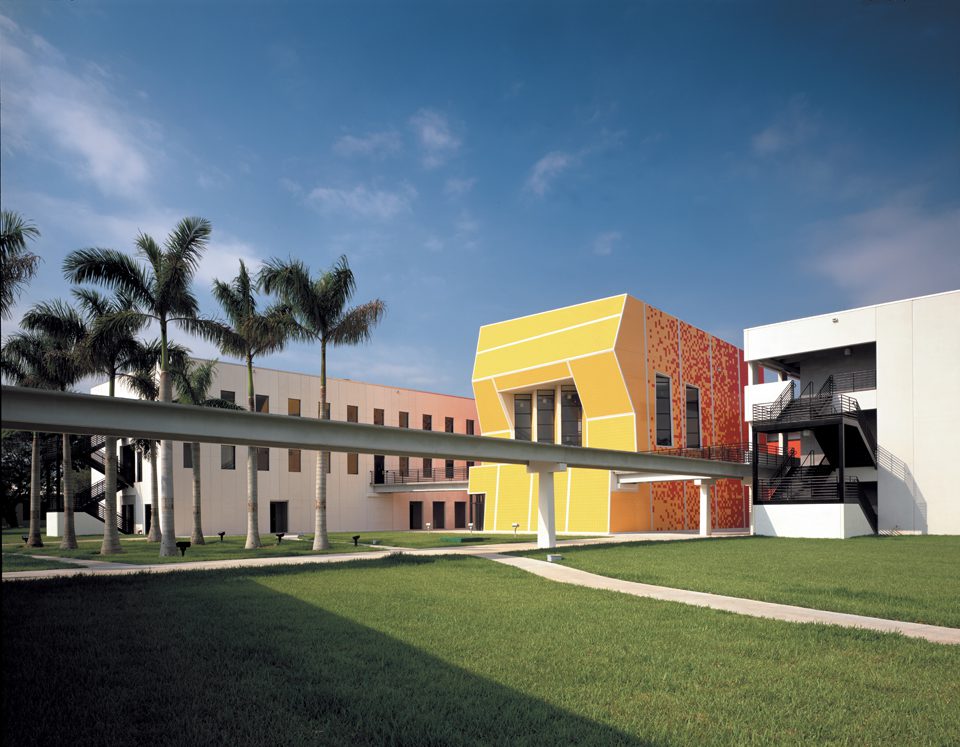Incorporating drawings, models, sketches and collages, Bernard Tschumi at the Pompidou Centre, Paris, explores the detailed and lengthy process of design involved in architecture.
In recent years cultural institutions across the world have seen a renaissance in architecture and architectural presentation. The vigour and enthusiasm with which the development of London and Bejing’s respective Olympic parks were reported in the mainstream press reached a fever pitch unfathomable 15 years ago. The constant development and new witty monikers of the latest high-rises to crop up on London’s skyline has become common parlance while the phenomenal growth in Dubai is a source of fascination with the ability of architects and engineers to achieve ever-higher feats.
Add to this, recent big-ticket shows on Richard Rogers and Sensing Spaces at the Royal Academy, and Thomas Heatherwick at the V&A, in addition to television’s roster of restoration programmes and Jonathan Meade’s recent esoteric defence of Brutalism, and it becomes clear that architecture is having its moment. Cultural consumers are establishing a re-appreciation of recent mid-20th century architecture previously derided, the so-called “starchitects” have become celebrities and there’s a clear indication that we are increasingly aware of the spaces in which we live, work and play.
The Pompidou Centre in Paris has been at the heart of this discourse with exhibitions dedicated to Jean Nouvel, Thom Mayne and Dominique Perrault. Indeed its very design is symptomatic of the revitalisation of public space that we’ve been experiencing since the 1980s with museums assuming exciting new forms either from headline-grabbing architects such as Renzo Piano/Richard Rogers’ Pompidou and Sejima + Nishizawa/SANAA-designed New Museum of Contemporary Art in New York, or innovative renovations to recapture the unique qualities of an existing overlooked space such as Tate Modern’s The Tanks and John Pawson’s careful remodelling of the former Commonwealth Institute for the Design Museum both in London.
However, amongst this anticipation and excitement over new projects and interrogation of architects’ working practices, there is an abstract, intellectualised element that is more elusive and difficult to explore. The Pompidou’s latest exhibition is dedicated to the work and theory of Bernard Tschumi and unusually, perhaps because Tschumi espouses more theory than most, equal weight is given to both his finalised projects, with the working processes behind them, and to his intellectualisation of the field and interdisciplinary studies into architecture not only as a space in which to live, but also as a proactive way to challenge the institutions of power and our commonplace acceptance of how buildings should be.
The exhibition is the first major European show of Tschumi’s works (the Museum of Modern Art in New York presented a monographic exhibition in 1994 but any assessment of Tschumi’s career has been surprisingly absent on his home soil). Having worked at Columbia University, New York from 1988 to 2003, Tschumi is well-established in intellectual circles in the USA as well as in the UK (where he taught at the Architectural Association in the 1970s). The exhibition’s co-curator, Aurélien Lemonier (Curator of Architecture, Musée National d’Art Moderne), attests that Tschumi is perhaps more at home in the Anglo nations but his influences (Jacques Derrida and Roland Barthes among them) are of a decidedly Gallic disposition: “He brought Jack Derrida’s theories to the question of architecture, to the issues of space and to the system of creating a new one.”
Furthermore, in acknowledging Tschumi’s hiatus from France’s museums Lemonier argues: “His contribution acknowledges the figure of the architect as an intellectual, and that may be why he went to London and then to New York because he didn’t feel very comfortable in France thinking in that way.” It was in London that his work established a direct influence from the British architect Cedric Price who “composed the idea of architecture as a structure for a social event,” and at Columbia Tschumi innovated the “paperless studio,” bringing computers into the concept and planning stages.
Tschumi’s unique contribution to his field lies in “this question of architecture as a language and as conceptual art not just as a formal academic form. However, he did not approach it in a post-modernism manner, much more in an abstract way.” Lemonier believes that for Tschumi, architecture is: “Not about form but about the deconstruction of it and not about drawing but about how to write architecture. This point is at the core of his position and it was very important for a cultural debate in the USA, more than in France.” For Lemonier, in spite of Tschumi’s protest that “he is not a landscape designer there is no question of that,” the soon-to-be-reopened Parc Zoologique de Paris and Tschumi’s original Parc de la Villette are the stand-out works (and conveniently, both situated in Paris, those best-placed for visitors to enjoy in actuality after attending the exhibition). Lemonier explains: “In his work he always thinks about the question of the garden, as a social event, as a space for architecture and as a counter-point to the city. I think the garden may be the key to understanding his practice.”
With Tschumi’s large body of work and his current high profile, “he is doing many things now in France [so] we have a large overview of his work,” the exhibition is broken down thematically (and simultaneously chronologically) into sections focusing on Space and Event, Program and Superimposition, Vectors and Envelopes, Context and Content, and the Concept-Form. “Those five chapters to me explain his work … They are allegorical, chronological and also thematic.” The serendipity of the exhibition following both chronological and thematical lines highlights the progression that Tschumi has made throughout his career and Space and Event has Tschumi’s first major project in Paris, Parc de la Villette, at its core, its presentation under Event highlighting the extra contribution that witnessing the projects in real life can bring to an exhibition: “Many people in Paris know it, so it is quite obvious to understand what happens in the garden is an event.” Program and Superimposition interrogates Le Fresnoy Art Center, as well as Tschumi’s competition entries from the 1980s. The chapter highlights Tschumi’s core ethos that space is implicit in creating the social structures of the people within it, and his argument against the use of architecture to impose the status quo.
Vector and Envelope takes the most traditional approach of an architecture exhibition in providing an opportunity for Tschumi “to explain how he critiques architecture … it’s a chapter more about architectural form and the context and content [of Tschumi’s work].” In conclusion Concept-Form highlights why Tschumi’s way of thinking is so influential in today’s highly competitive architectural industry of pitches and competitions: “when you do a competition you just have two weeks to design the building so you have to construct the form hypothetically. If you win, you reflect in the structure and the complexity of the architecture the use of the space.” It illustrates the role of concept-led architecture in today’s landscape. Moreover, Tschumi espouses the cross-cultural currents between architecture and other art forms, and his openness to the theories and works of artists, writers and filmmakers leads Lemonier to describe his role as “not at the centre of the architecture but on the margin …The main idea of Tschumi is a question of import and export – he wants to overlap film and art with the construction of a building in order to make an interaction. [He] interacts and uses a critical reading of Roland Barthes or James Joyce to challenge his reading of architecture.”
Lemonier co-curated the exhibition with Frédéric Migayrou, (Deputy Director, Collections of Architecture and Design, Musée National d’Art Moderne) and he states the importance of Tschumi in the architectural landscape: “He is one of the only practitioners who thinks of architecture in conceptual terms. He put forward a post structural debate that offered a new way of thinking about the form for a new generation of architects. He was on the same page as Rem Koolhaas and Zaha Hadid.”
Still practising, theorising and building, Tschumi himself was very involved in the process of planning the exhibition and even designed an installation featuring archival plans and films. “We worked very closely together. For the first time Tschumi literally opened his archive, so [we saw] all his first drawings and it’s very unique because they have never been exhibited before.” The curators and the architect met regularly in France and so, for Tschumi as well as Lemonier and Migayrou, it was a process of discovery and re-discovery, and a very interior process because now had come the time to reflect on his work. In addition, Tschumi designed the exhibition’s sceneography as “part of this process of looking at himself, he designed the scenography in the exhibition itself,” which in a manner moved the architect to the position of visitor, whereby he must imagine how people would proceed through the exhibition.
Herein lies one of the difficulties of presenting architecture and Tschumi’s architecture and theory are particularly vulnerable. In spite of our new appetite for the medium, architectural exhibitions are notoriously difficult to mount, as Lemonier explains: “What do you show about architecture? Not the architecture itself but you show that it is a process of design.” Whereas authenticity is paramount in most museum shows, the authenticity of the work is essentially impossible for an architectural exhibition. Despite the curators’ best efforts, the majority of visitors will not have seen many (or any) of Tschumi’s works in real life. And while the Royal Academy’s recent Sensing Spaces exhibition took an innovative approach to commissioning architectural practices to create actual spaces, in many ways that approach has its quandaries because it doesn’t ensure that audiences see the architect’s best works; there is a possibility that the architects and curators are hampered by constraints in space and expense. Yet, it is often in these moments that true innovation can occur and an exhibition created that breaks new ground. This presentation takes a traditional exhibition and fully exploits the archives with an extensive exploration of his drawings and scale models. In showing the working process Lemonier believes: “For Tschumi it fits very well because he considers the architect as an intellectual and the question around the process of design is at the core of his own position. All of his sketches have autonomy; they can be understood individually.”
With his emphasis on theory over form, and language over drawing, it’s inevitable that Tschumi’s exhibition will be a hard sell for visual audiences. While the theory draws you in, without experiencing the buildings themselves it can be difficult to contextualise, and Lemonier acknowledges: “The theoretical position of Tschumi is quite complicated [but] that’s why the drawings are important.” In essence Lemonier hopes that the beauty of Tschumi’s drawings will speak for themselves: “The drawings are fascinating” and they add “an emotional aspect to the visit … There is also a second line of exploration for the exhibition: of asking what the pieces mean. If visitors would like to delve deeper into understanding their cultural relationship with other theorists like Jack Derrida then there is the catalogue available for further reading.” Lemonier, however, does not shy away from leading the show with concepts, and this marks Bernard Tschumi as radically different from popular architectural presentations: “We are looking at architecture as a cultural event, not just as a guide of how to construct a building. In addition to the images of his works we also show what Tschumi thought the cultural position of a building should be, what it should be used for and the social, economic, intellectual position of architecture. People are not coming to the exhibition to look at a documentary of the practice, they are visiting to understand the cultural impact and importance of architecture.”
Bernard Tschumi runs at the Pompidou Centre 30 April – 28 July. For tickets and further information, visit www.centrepompidou.fr.
Ruby Beesley





